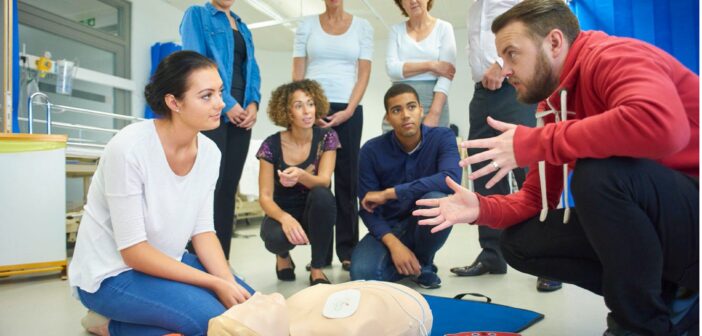Prompt action is crucial when you encounter someone who has collapsed with an apparent cardiac arrest. In the UK, where 30,000 people experience such incidents outside hospitals, only 1 in 10 survive without intervention.
Learn how to do CPR by attending a CPR training course and gaining access to defibrillators can double survival rates, emphasising the importance of equipping more individuals with this life-saving skill.
Topics covered during CPR classes
The following topics are covered during CPR classes:
- Cardiopulmonary Resuscitation (CPR)
- Automated External Defibrillation (AED)
- Airway Obstruction
- Recovery Position
- Identifying Life-Threatening Conditions
- Heart Attack
- Stroke
- Cardiac Arrest
- Choking
- Allergic Reaction – Anaphylaxis
Importance of CPR Training
CPR is a vital life-saving skill that everyone should possess. In emergencies, waiting for medical professionals is only sometimes an option. CPR training instils confidence in chest compressions and rescue breaths, increasing the chances of saving lives.
Regular training keeps us updated on the latest techniques and builds confidence for effective response in emergencies, improving the survival rate for cardiac arrest victims.
A brief guide to doing CPR
If you gain the required knowledge and self-confidence to do a few simple actions during emergencies, it can make a lot of difference between a person’s life and death. Your quick response can save a life. Look around to make sure there is no danger before approaching the individual who has fallen.
- Shout for help
Call for assistance and give the person who has fallen a gentle shake.
- Listen for and observe indications of regular breathing
See how their chest rises and falls.
- Call 999
Turn on the speakerphone on your phone and inform them that you are with someone, not breathing at all.
- Start chest compressions
- Put your fingers together.
- Hold your hands in the centre of your chest.
- Push down hard, go on releasing two times per second, and continue doing it.
- The call handler for the ambulance will assist you.
- The ambulance call handler will inform you where the nearest AED (automated external defibrillator) is. If someone is present with you, ask them to get it and bring it back.
Don’t leave the person if you are alone.
- Switch your defibrillator on and follow the necessary instructions. These devices are essential for restoring a normal heart rhythm during cardiac emergencies.
The defibrillator will provide you with detailed instructions.
- Continue CPR
Continue with CPR until:
- The AED requests that you wait while it reanalyses and, if necessary, administers another shock.
- A paramedic shows up and gives you instructions.
- The individual exhibits vital signs.
Who can I discuss afterwards?
Experiencing or witnessing a cardiac arrest can be traumatic. Seeking support from a psychologist or discussing the experience with medical professionals can help in the recovery process, especially if you had to administer CPR.
Talking about the incident with healthcare providers or ambulance staff can provide an opportunity for understanding and healing.
Conclusion
CPR is a fundamental skill that empowers individuals to take immediate, life-saving action in critical situations. It is essential, as waiting for professional help is often not feasible.
CPR training instils confidence and keeps us informed about evolving techniques. Regular practice and updated knowledge enhance our ability to respond effectively, significantly improving the chances of survival for cardiac arrest victims.





